Nonimmigrants vs Potawatomi Community Comparison
COMPARE
Nonimmigrants
Potawatomi
Social Comparison
Social Comparison
Nonimmigrants
Potawatomi
3,083
SOCIAL INDEX
28.4/ 100
SOCIAL RATING
234th/ 347
SOCIAL RANK
3,223
SOCIAL INDEX
29.8/ 100
SOCIAL RATING
227th/ 347
SOCIAL RANK
Potawatomi Integration in Nonimmigrants Communities
The statistical analysis conducted on geographies consisting of 117,342,138 people shows a mild positive correlation between the proportion of Potawatomi within Nonimmigrant communities in the United States with a correlation coefficient (R) of 0.376. On average, for every 1% (one percent) increase in Nonimmigrants within a typical geography, there is an increase of 0.002% in Potawatomi. To illustrate, in a geography comprising of 100,000 individuals, a rise of 1,000 Nonimmigrants corresponds to an increase of 1.9 Potawatomi.
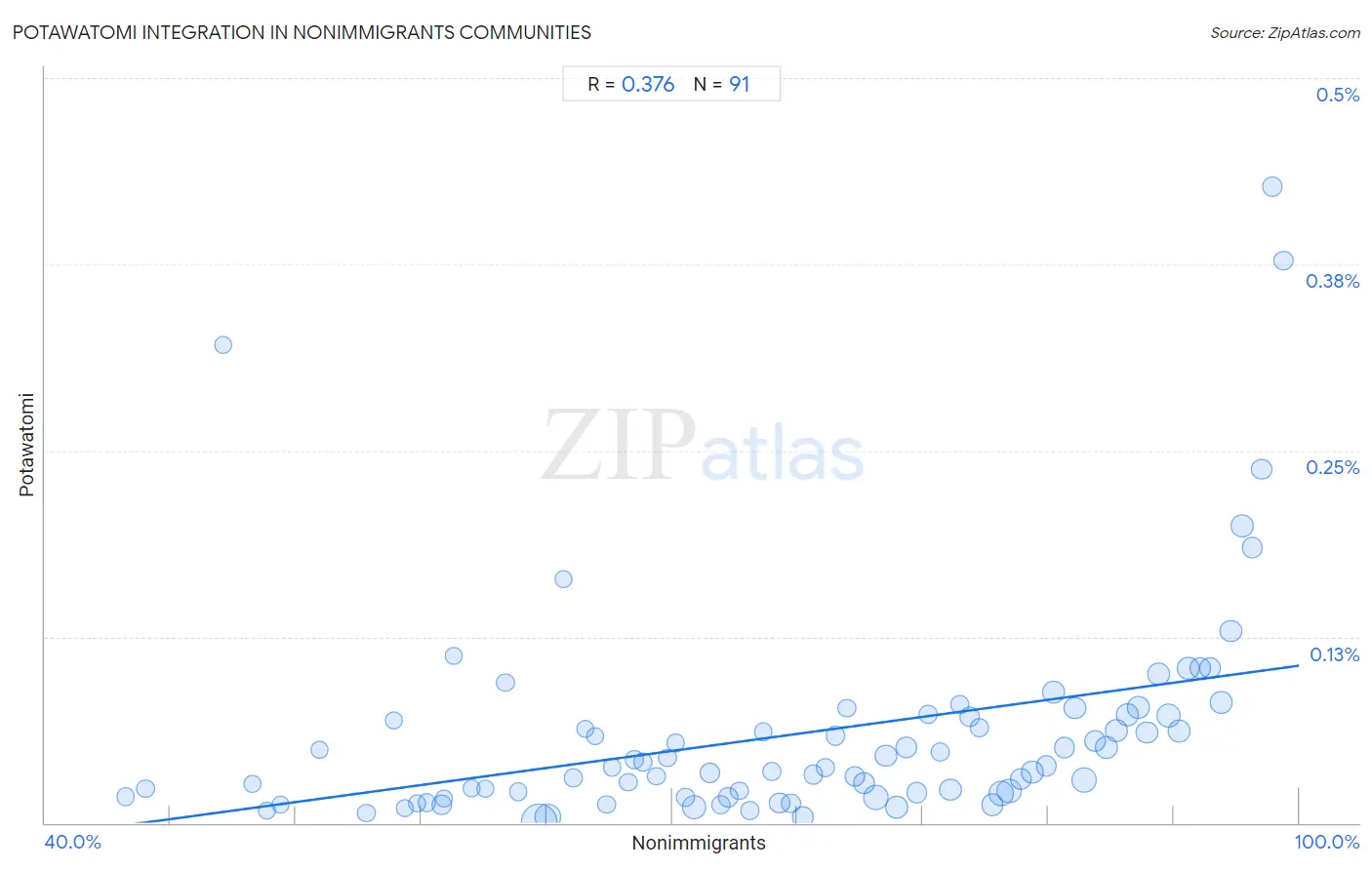
Nonimmigrants vs Potawatomi Income
When considering income, the most significant differences between Nonimmigrants and Potawatomi communities in the United States are seen in householder income ages 45 - 64 years ($94,448 compared to $84,613, a difference of 11.6%), median household income ($79,429 compared to $72,576, a difference of 9.4%), and median family income ($96,231 compared to $88,265, a difference of 9.0%). Conversely, both communities are more comparable in terms of wage/income gap (27.2% compared to 27.7%, a difference of 2.0%), householder income over 65 years ($57,426 compared to $54,212, a difference of 5.9%), and householder income under 25 years ($49,348 compared to $46,462, a difference of 6.2%).

| Income Metric | Nonimmigrants | Potawatomi |
| Per Capita Income | Tragic $40,669 | Tragic $38,046 |
| Median Family Income | Tragic $96,231 | Tragic $88,265 |
| Median Household Income | Tragic $79,429 | Tragic $72,576 |
| Median Earnings | Tragic $44,117 | Tragic $41,288 |
| Median Male Earnings | Tragic $52,170 | Tragic $48,768 |
| Median Female Earnings | Tragic $37,024 | Tragic $34,739 |
| Householder Age | Under 25 years | Tragic $49,348 | Tragic $46,462 |
| Householder Age | 25 - 44 years | Tragic $88,301 | Tragic $81,774 |
| Householder Age | 45 - 64 years | Tragic $94,448 | Tragic $84,613 |
| Householder Age | Over 65 years | Tragic $57,426 | Tragic $54,212 |
| Wage/Income Gap | Tragic 27.2% | Tragic 27.7% |
Nonimmigrants vs Potawatomi Poverty
When considering poverty, the most significant differences between Nonimmigrants and Potawatomi communities in the United States are seen in female poverty among 18-24 year olds (21.5% compared to 23.7%, a difference of 10.1%), single male poverty (14.6% compared to 15.8%, a difference of 8.2%), and single female poverty (23.6% compared to 25.4%, a difference of 7.6%). Conversely, both communities are more comparable in terms of single father poverty (18.8% compared to 18.9%, a difference of 0.25%), seniors poverty over the age of 65 (10.9% compared to 10.8%, a difference of 0.70%), and receiving food stamps (12.4% compared to 12.5%, a difference of 0.75%).
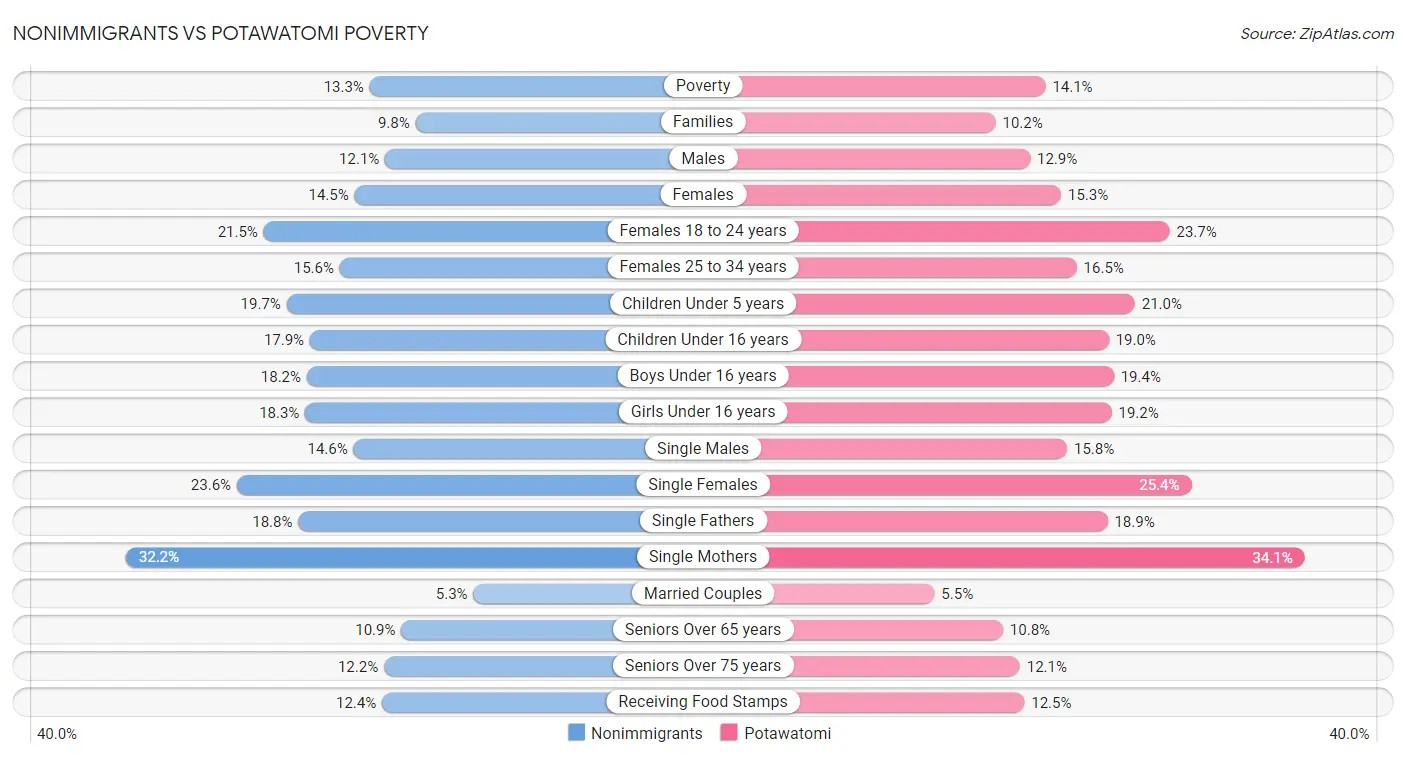
| Poverty Metric | Nonimmigrants | Potawatomi |
| Poverty | Tragic 13.3% | Tragic 14.1% |
| Families | Tragic 9.8% | Tragic 10.2% |
| Males | Tragic 12.1% | Tragic 12.9% |
| Females | Tragic 14.5% | Tragic 15.3% |
| Females 18 to 24 years | Tragic 21.5% | Tragic 23.7% |
| Females 25 to 34 years | Tragic 15.6% | Tragic 16.5% |
| Children Under 5 years | Tragic 19.7% | Tragic 21.0% |
| Children Under 16 years | Tragic 17.9% | Tragic 19.0% |
| Boys Under 16 years | Tragic 18.2% | Tragic 19.4% |
| Girls Under 16 years | Tragic 18.3% | Tragic 19.2% |
| Single Males | Tragic 14.6% | Tragic 15.8% |
| Single Females | Tragic 23.6% | Tragic 25.4% |
| Single Fathers | Tragic 18.8% | Tragic 18.9% |
| Single Mothers | Tragic 32.2% | Tragic 34.1% |
| Married Couples | Fair 5.3% | Poor 5.5% |
| Seniors Over 65 years | Average 10.9% | Good 10.8% |
| Seniors Over 75 years | Average 12.2% | Average 12.1% |
| Receiving Food Stamps | Poor 12.4% | Poor 12.5% |
Nonimmigrants vs Potawatomi Unemployment
When considering unemployment, the most significant differences between Nonimmigrants and Potawatomi communities in the United States are seen in unemployment among seniors over 75 years (9.8% compared to 7.8%, a difference of 25.7%), unemployment among women with children ages 6 to 17 years (10.0% compared to 8.5%, a difference of 17.6%), and unemployment among women with children under 6 years (8.8% compared to 9.6%, a difference of 8.3%). Conversely, both communities are more comparable in terms of unemployment among ages 30 to 34 years (6.1% compared to 6.0%, a difference of 0.34%), unemployment among seniors over 65 years (5.1% compared to 5.1%, a difference of 0.35%), and unemployment among ages 25 to 29 years (7.1% compared to 7.1%, a difference of 0.50%).
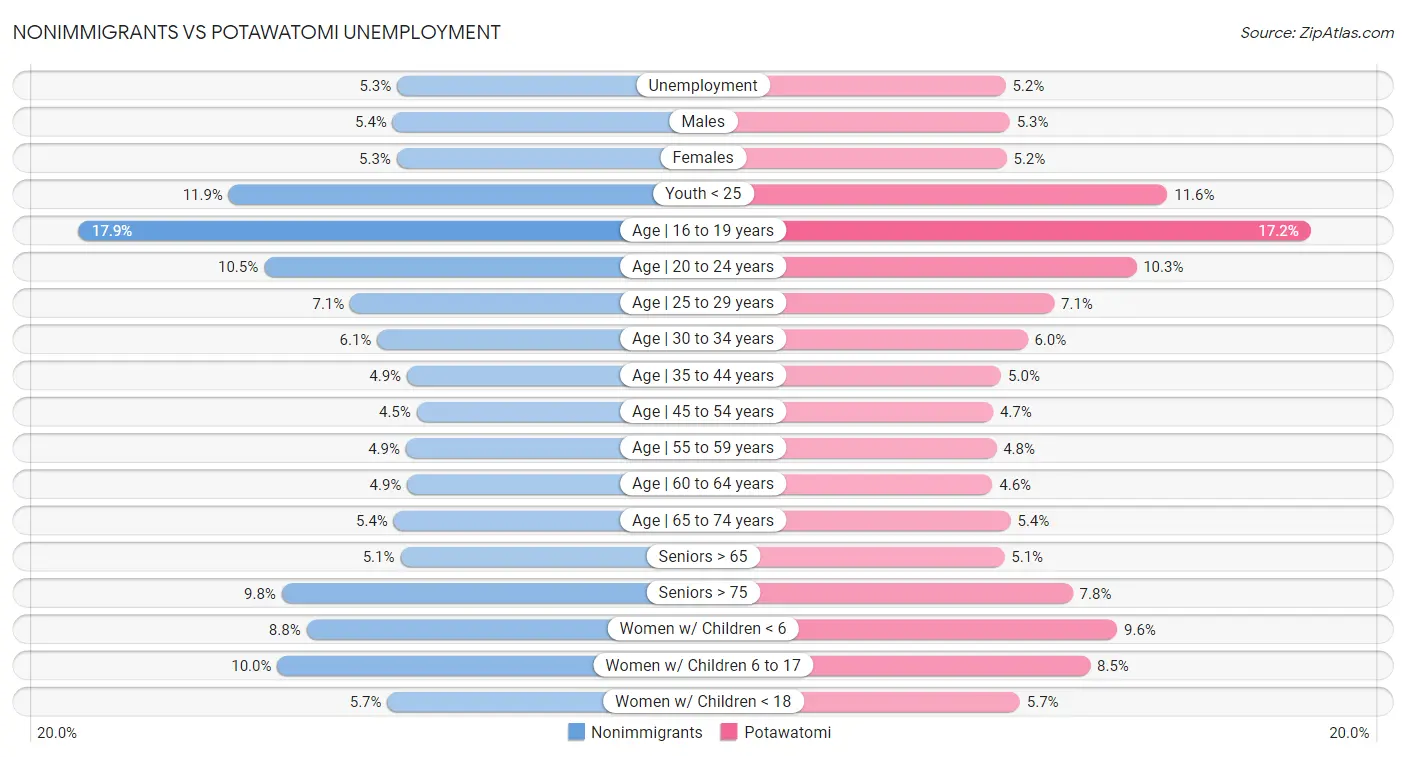
| Unemployment Metric | Nonimmigrants | Potawatomi |
| Unemployment | Average 5.3% | Good 5.2% |
| Males | Poor 5.4% | Fair 5.3% |
| Females | Average 5.3% | Good 5.2% |
| Youth < 25 | Tragic 11.9% | Average 11.6% |
| Age | 16 to 19 years | Fair 17.9% | Excellent 17.2% |
| Age | 20 to 24 years | Tragic 10.5% | Average 10.3% |
| Age | 25 to 29 years | Tragic 7.1% | Tragic 7.1% |
| Age | 30 to 34 years | Tragic 6.1% | Tragic 6.0% |
| Age | 35 to 44 years | Tragic 4.9% | Tragic 5.0% |
| Age | 45 to 54 years | Good 4.5% | Tragic 4.7% |
| Age | 55 to 59 years | Poor 4.9% | Good 4.8% |
| Age | 60 to 64 years | Average 4.9% | Exceptional 4.6% |
| Age | 65 to 74 years | Fair 5.4% | Average 5.4% |
| Seniors > 65 | Average 5.1% | Good 5.1% |
| Seniors > 75 | Tragic 9.8% | Exceptional 7.8% |
| Women w/ Children < 6 | Tragic 8.8% | Tragic 9.6% |
| Women w/ Children 6 to 17 | Tragic 10.0% | Exceptional 8.5% |
| Women w/ Children < 18 | Poor 5.7% | Tragic 5.7% |
Nonimmigrants vs Potawatomi Labor Participation
When considering labor participation, the most significant differences between Nonimmigrants and Potawatomi communities in the United States are seen in in labor force | age 45-54 (81.2% compared to 80.0%, a difference of 1.6%), in labor force | age 20-64 (78.1% compared to 77.2%, a difference of 1.1%), and in labor force | age > 16 (63.5% compared to 62.8%, a difference of 1.1%). Conversely, both communities are more comparable in terms of in labor force | age 20-24 (76.2% compared to 76.2%, a difference of 0.010%), in labor force | age 16-19 (40.1% compared to 40.0%, a difference of 0.14%), and in labor force | age 35-44 (83.2% compared to 82.7%, a difference of 0.63%).

| Labor Participation Metric | Nonimmigrants | Potawatomi |
| In Labor Force | Age > 16 | Tragic 63.5% | Tragic 62.8% |
| In Labor Force | Age 20-64 | Tragic 78.1% | Tragic 77.2% |
| In Labor Force | Age 16-19 | Exceptional 40.1% | Exceptional 40.0% |
| In Labor Force | Age 20-24 | Exceptional 76.2% | Exceptional 76.2% |
| In Labor Force | Age 25-29 | Tragic 83.7% | Tragic 82.9% |
| In Labor Force | Age 30-34 | Tragic 83.5% | Tragic 82.8% |
| In Labor Force | Age 35-44 | Tragic 83.2% | Tragic 82.7% |
| In Labor Force | Age 45-54 | Tragic 81.2% | Tragic 80.0% |
Nonimmigrants vs Potawatomi Family Structure
When considering family structure, the most significant differences between Nonimmigrants and Potawatomi communities in the United States are seen in divorced or separated (12.8% compared to 13.5%, a difference of 5.5%), single father households (2.4% compared to 2.5%, a difference of 3.1%), and married-couple households (46.9% compared to 45.7%, a difference of 2.6%). Conversely, both communities are more comparable in terms of average family size (3.19 compared to 3.16, a difference of 0.71%), currently married (46.9% compared to 46.5%, a difference of 0.88%), and single mother households (6.7% compared to 6.6%, a difference of 1.2%).

| Family Structure Metric | Nonimmigrants | Potawatomi |
| Family Households | Exceptional 64.8% | Tragic 63.3% |
| Family Households with Children | Good 27.5% | Tragic 26.9% |
| Married-couple Households | Good 46.9% | Poor 45.7% |
| Average Family Size | Tragic 3.19 | Tragic 3.16 |
| Single Father Households | Tragic 2.4% | Tragic 2.5% |
| Single Mother Households | Poor 6.7% | Poor 6.6% |
| Currently Married | Good 46.9% | Average 46.5% |
| Divorced or Separated | Tragic 12.8% | Tragic 13.5% |
| Births to Unmarried Women | Tragic 35.5% | Tragic 36.2% |
Nonimmigrants vs Potawatomi Vehicle Availability
When considering vehicle availability, the most significant differences between Nonimmigrants and Potawatomi communities in the United States are seen in no vehicles in household (7.9% compared to 8.8%, a difference of 11.9%), 2 or more vehicles in household (58.8% compared to 58.0%, a difference of 1.4%), and 1 or more vehicles in household (92.2% compared to 91.3%, a difference of 1.0%). Conversely, both communities are more comparable in terms of 3 or more vehicles in household (21.8% compared to 21.9%, a difference of 0.43%), 4 or more vehicles in household (7.2% compared to 7.3%, a difference of 0.76%), and 1 or more vehicles in household (92.2% compared to 91.3%, a difference of 1.0%).

| Vehicle Availability Metric | Nonimmigrants | Potawatomi |
| No Vehicles Available | Exceptional 7.9% | Exceptional 8.8% |
| 1+ Vehicles Available | Exceptional 92.2% | Exceptional 91.3% |
| 2+ Vehicles Available | Exceptional 58.8% | Exceptional 58.0% |
| 3+ Vehicles Available | Exceptional 21.8% | Exceptional 21.9% |
| 4+ Vehicles Available | Exceptional 7.2% | Exceptional 7.3% |
Nonimmigrants vs Potawatomi Education Level
When considering education level, the most significant differences between Nonimmigrants and Potawatomi communities in the United States are seen in master's degree (13.3% compared to 12.1%, a difference of 10.5%), professional degree (3.9% compared to 3.6%, a difference of 9.5%), and doctorate degree (1.7% compared to 1.6%, a difference of 7.7%). Conversely, both communities are more comparable in terms of nursery school (98.3% compared to 98.3%, a difference of 0.050%), 1st grade (98.2% compared to 98.3%, a difference of 0.050%), and 2nd grade (98.2% compared to 98.2%, a difference of 0.050%).
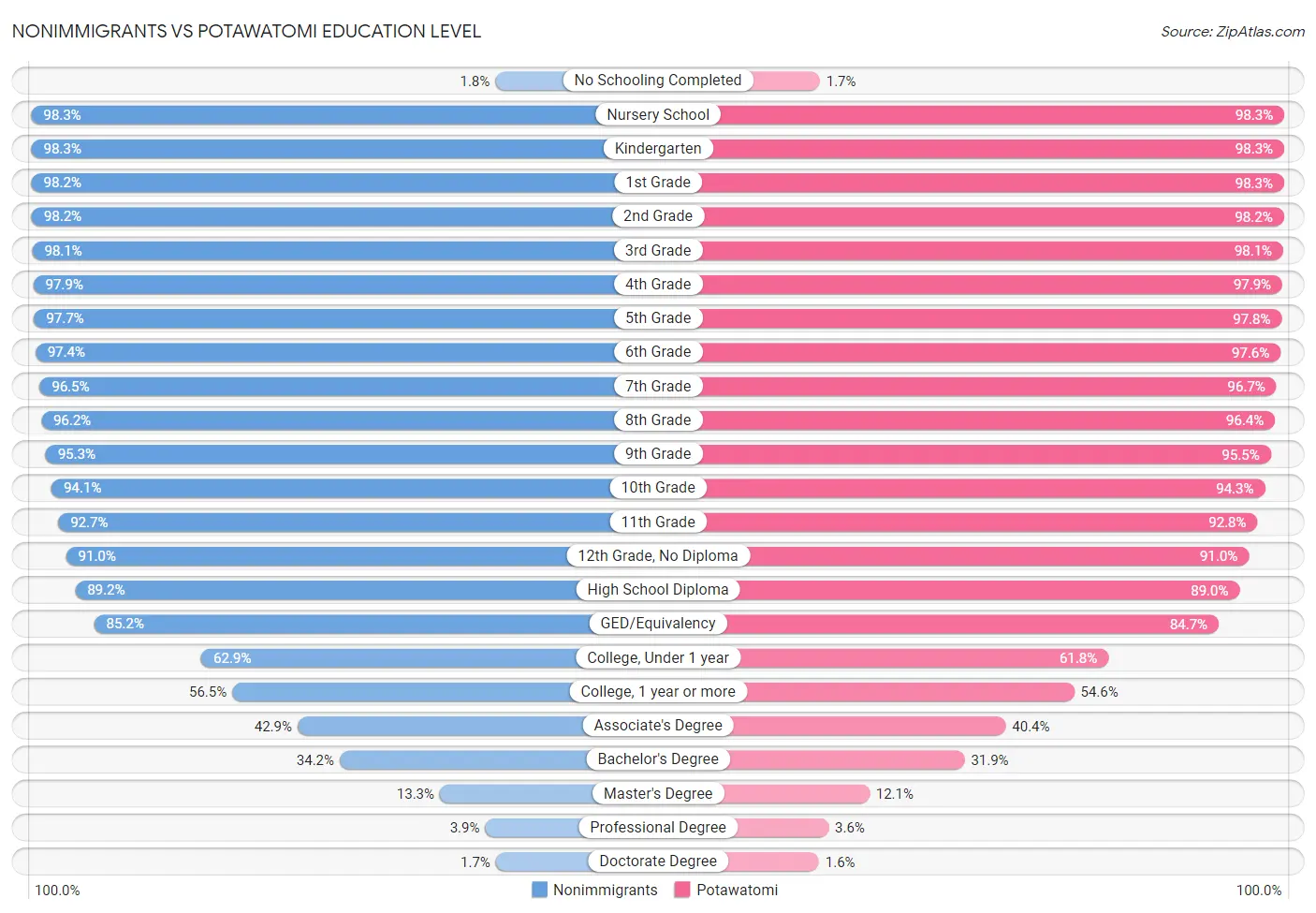
| Education Level Metric | Nonimmigrants | Potawatomi |
| No Schooling Completed | Exceptional 1.8% | Exceptional 1.7% |
| Nursery School | Exceptional 98.3% | Exceptional 98.3% |
| Kindergarten | Exceptional 98.3% | Exceptional 98.3% |
| 1st Grade | Exceptional 98.2% | Exceptional 98.3% |
| 2nd Grade | Exceptional 98.2% | Exceptional 98.2% |
| 3rd Grade | Exceptional 98.1% | Exceptional 98.1% |
| 4th Grade | Exceptional 97.9% | Exceptional 97.9% |
| 5th Grade | Exceptional 97.7% | Exceptional 97.8% |
| 6th Grade | Exceptional 97.4% | Exceptional 97.6% |
| 7th Grade | Exceptional 96.5% | Exceptional 96.7% |
| 8th Grade | Exceptional 96.2% | Exceptional 96.4% |
| 9th Grade | Exceptional 95.3% | Exceptional 95.5% |
| 10th Grade | Excellent 94.1% | Exceptional 94.3% |
| 11th Grade | Good 92.7% | Good 92.8% |
| 12th Grade, No Diploma | Fair 91.0% | Fair 91.0% |
| High School Diploma | Average 89.2% | Average 89.0% |
| GED/Equivalency | Fair 85.2% | Tragic 84.7% |
| College, Under 1 year | Tragic 62.9% | Tragic 61.8% |
| College, 1 year or more | Tragic 56.5% | Tragic 54.6% |
| Associate's Degree | Tragic 42.9% | Tragic 40.4% |
| Bachelor's Degree | Tragic 34.2% | Tragic 31.9% |
| Master's Degree | Tragic 13.3% | Tragic 12.1% |
| Professional Degree | Tragic 3.9% | Tragic 3.6% |
| Doctorate Degree | Tragic 1.7% | Tragic 1.6% |
Nonimmigrants vs Potawatomi Disability
When considering disability, the most significant differences between Nonimmigrants and Potawatomi communities in the United States are seen in disability age under 5 (1.6% compared to 1.4%, a difference of 17.6%), hearing disability (3.6% compared to 4.1%, a difference of 15.1%), and disability age 35 to 64 (13.0% compared to 14.8%, a difference of 13.1%). Conversely, both communities are more comparable in terms of self-care disability (2.6% compared to 2.6%, a difference of 0.070%), disability age over 75 (48.0% compared to 49.0%, a difference of 2.1%), and disability age 5 to 17 (6.3% compared to 6.5%, a difference of 3.6%).
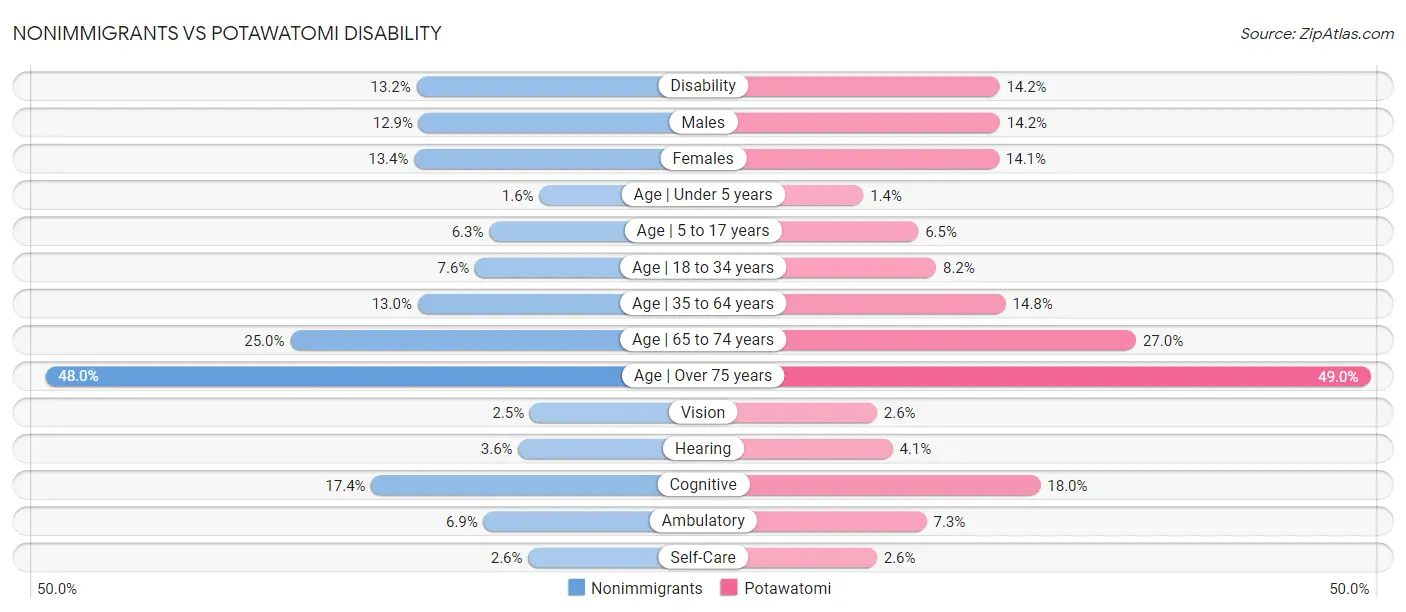
| Disability Metric | Nonimmigrants | Potawatomi |
| Disability | Tragic 13.2% | Tragic 14.2% |
| Males | Tragic 12.9% | Tragic 14.2% |
| Females | Tragic 13.4% | Tragic 14.1% |
| Age | Under 5 years | Tragic 1.6% | Tragic 1.4% |
| Age | 5 to 17 years | Tragic 6.3% | Tragic 6.5% |
| Age | 18 to 34 years | Tragic 7.6% | Tragic 8.2% |
| Age | 35 to 64 years | Tragic 13.0% | Tragic 14.8% |
| Age | 65 to 74 years | Tragic 25.0% | Tragic 27.0% |
| Age | Over 75 years | Tragic 48.0% | Tragic 49.0% |
| Vision | Tragic 2.5% | Tragic 2.6% |
| Hearing | Tragic 3.6% | Tragic 4.1% |
| Cognitive | Fair 17.4% | Tragic 18.0% |
| Ambulatory | Tragic 6.9% | Tragic 7.3% |
| Self-Care | Tragic 2.6% | Tragic 2.6% |